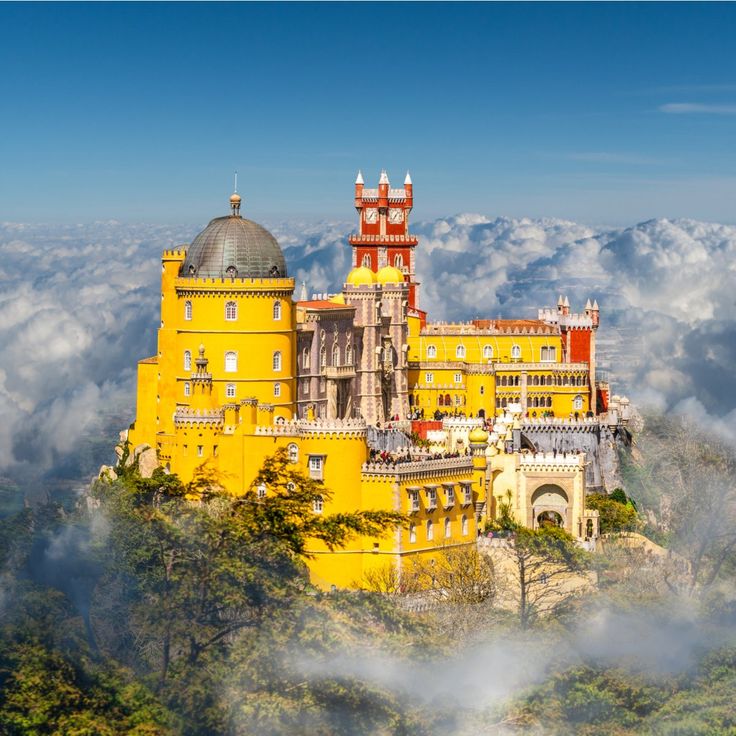Palácio da Pena: A Majestic Icon of Portugal’s Heritage
The Palácio da Pena is one of the most iconic landmarks in Portugal and a testament to the country’s rich history, culture, and architectural marvel. Situated in the town of Sintra, just outside Lisbon, this palace is a UNESCO World Heritage site and attracts millions of visitors each year. Let’s dive into the captivating history, daily life impacts, and significance of this stunning palace that continues to inspire awe and admiration.
History of Palácio da Pena
The construction of Palácio da Pena began in the mid-19th century under the directive of King Ferdinand II, who sought to transform the existing monastery into a royal residence. The site originally housed the Mosteiro de São Jerónimo, a monastery built in the 16th century, which was severely damaged by the 1755 earthquake. King Ferdinand II envisioned a palace that would blend romanticism with medieval, Gothic, Renaissance, and Manueline styles. The final design, a mix of vibrant colors and intricate architecture, was completed in 1885, although the work continued in small phases.
Over the years, the palace has had various roles, from serving as a royal residence to being a public museum. It is now one of Portugal’s most cherished monuments, symbolizing the rich and diverse cultural heritage of the country.
Significance and Impact on Society
The Palácio da Pena holds great significance both in Portuguese history and in global architectural design. Its eclectic mix of styles demonstrates the creativity and ingenuity of its architect, Baron von Eschwege, who combined different influences to create an unforgettable monument. The castle’s colorful exterior, with its bright reds, yellows, and greens, stands out against the natural beauty of the surrounding Sintra mountains, making it one of the most photographed landmarks in Portugal.
The palace plays a crucial role in the local economy by attracting tourists from around the world. Its breathtaking design and stunning views of Sintra and the Lisbon coast have made it a significant cultural asset. Beyond tourism, Palácio da Pena is an important symbol of Portugal’s monarchy and is widely recognized as a national treasure.
Important Points and FAQs About Palácio da Pena
- What Is the Architectural Style of Palácio da Pena? The architecture of Palácio da Pena is a blend of Gothic, Renaissance, Manueline, Moorish, and Romantic styles. It is a brilliant example of 19th-century Romanticism, showcasing a fusion of these various elements that evoke a sense of whimsy and grandeur.
- How Did the 1755 Earthquake Affect the Palace? The devastating earthquake in 1755 destroyed much of the original monastery on the site. King Ferdinand II used this as an opportunity to transform the ruins into a magnificent palace. The earthquake’s impact can still be seen in the ruined parts of the monastery that blend seamlessly with the palace.
- What Role Does the Palace Play in Portuguese Culture? As a UNESCO World Heritage site, Palácio da Pena is a major cultural landmark, representing the romantic imagination and eclectic architectural designs of the time. It serves as a symbol of Portugal’s royal history, its architectural innovation, and the country’s artistic heritage.
- When Can Visitors Tour the Palace? The palace is open to the public year-round, though it can get crowded during the peak tourist season. Visitors can explore the vibrant interiors, walk around the lush gardens, and enjoy panoramic views from the palace’s elevated towers.
- Is There a Hidden Meaning Behind the Colors of the Palace? The vibrant colors of the palace, including the distinctive red and yellow, are not just aesthetic choices but symbolic representations. The red is thought to represent the royal bloodline, while the yellow symbolizes the sun and the golden era of the Portuguese monarchy.
- Can You Visit the Interior of the Palace? Yes! Inside, visitors can admire the lavish interiors, including the grand halls, the king’s private chambers, and the royal chapel. The furniture and artwork reflect the 19th-century royal lifestyle.
Daily Life Impacts of Palácio da Pena
The presence of Palácio da Pena has significantly impacted daily life in Sintra. As a popular tourist destination, the palace contributes to the local economy by providing jobs in hospitality, tourism, and conservation efforts. The influx of visitors has led to improved infrastructure and services in the area, benefiting both locals and tourists alike.
However, the large number of visitors can also put pressure on the local environment. Efforts are constantly made to preserve the natural beauty surrounding the palace, including the Parque da Pena, which is home to rare plants and wildlife.
Wishing and Observance: A Place for Reflection
For many, visiting Palácio da Pena is a chance to reflect on the past while being inspired by the grandeur of the architecture. It is a place where visitors can take in the beauty of Portugal’s history, ponder its royal past, and imagine life in a time of monarchy. The palace’s significance goes beyond mere sightseeing; it invites visitors to connect with a bygone era, filled with romance, mystery, and imagination.
Conclusion: A National Treasure
In conclusion, Palácio da Pena is more than just a royal palace—it is an enduring symbol of Portugal’s cultural and architectural heritage. With its rich history, stunning design, and ongoing significance, the palace continues to capture the hearts of all who visit. It stands as a reminder of Portugal’s royal past and the creative spirit that shapes its future. Whether you’re a history buff, architecture enthusiast, or simply someone looking for a beautiful place to visit, Palácio da Pena offers something unforgettable for everyone.
By preserving and sharing this monument, we ensure that future generations will also be able to admire and cherish this incredible piece of Portugal’s history.










